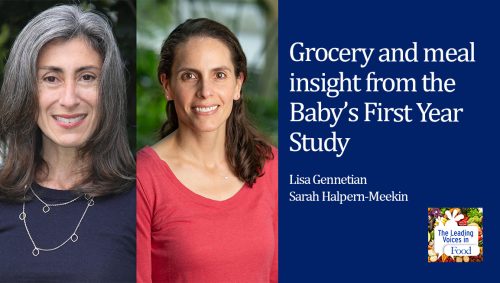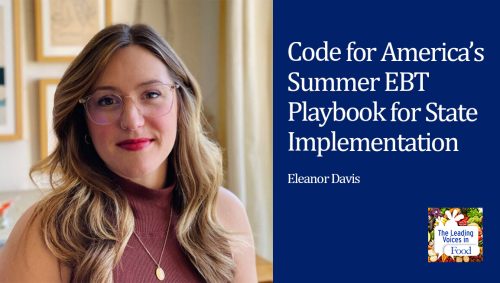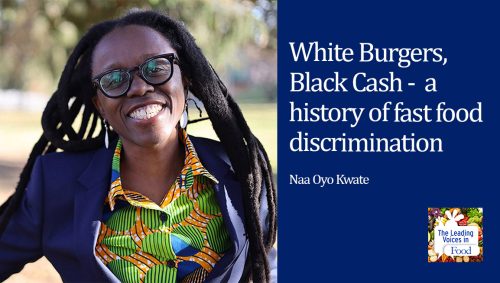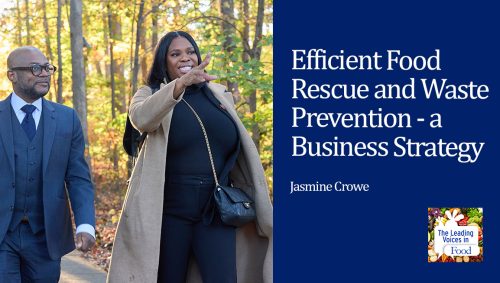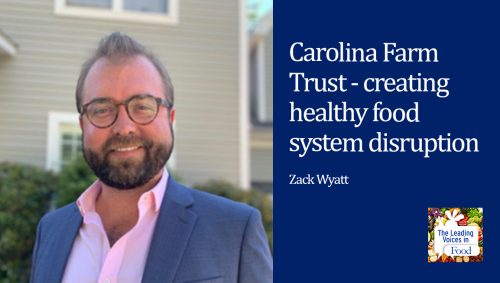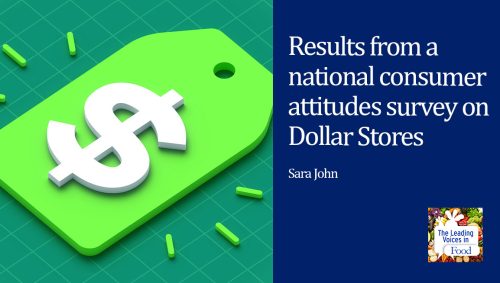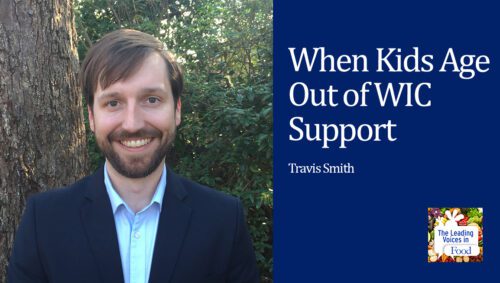The Leading Voices in Food
E190: Insights from 2nd Global Survey of School Meals
School meal programs provide children with needed meals, snacks, and even take home foods throughout the world. These programs have a tremendous impact on children’s overall nutrition, physical, and emotional development, and their academic performance, as you can imagine. Much can be learned from a project that is entitled The Global Survey of School Meal Programs. Today we will be speaking about the second such survey with Global Child Nutrition Foundation Research Coordinator, Ayala Wineman, from Michigan State University.
Subscribe: Apple Podcasts | TuneIN | Google Podcasts | SoundCloud | PocketCasts | Radio Public
Tags: Child Development & Nutrition | Equity, Race & Food Justice | Food Insecurity | School Meals |

Ayala Wineman is the Research Coordinator for the Global Child Nutrition Foundation (GCNF) and a Research Associate in the Department of Agricultural, Food, and Resource Economics at Michigan State University (MSU). She holds a M.Sc. and Ph.D. in Agricultural, Food, and Resource Economics. She has been engaged with GCNF and the Global Survey of School Meal Programs © since 2018. Her research relates to broadly to food security and agrifood transitions, primarily (but not only) in sub-Saharan Africa.
Interview Summary
Well, this is a really interesting topic, and a lot of people don’t think beyond the borders of the US when they think of school meals, but this really is a global issue and the place where countries can learn from one another. So let me ask you first, what is the Global Survey of School Meals, and what do you hope to accomplish with this work?
The Global Survey of School Meal programs is a survey that is administered at the country level. It is designed to gather information about school feeding, in a manner that is very standardized, very consistent, in how the information was collected. Before the Global Survey was introduced in 2019, the data landscape on school feeding was very fragmented, very spotty. You would find good information about school feeding for one country, but not for another country. You could find good information about what is happening with school feeding for one year, but it would then not be updated. And, you’d be able to find information much more easily for programs that were implemented by international development partners, like the World Food Program. But, it was much more difficult to find information about programs that were implemented by national governments. So with this kind of fragmented data landscape it was hard to understand what was going on across all the different countries, and also hard to see how things were changing over time. The Global Child Nutrition Foundation introduced the Global Survey of School Meal Programs in 2019, in order to address this knowledge gap.
The survey asks for information about a whole range of topics. So in every country it asks for information on the numbers and characteristics of beneficiaries, the avenues through which school feeding programs procure food, the modalities through which they distribute food to the children. It asks about funding, about the extent of government involvement, related health and sanitation interventions. In the second round of the survey, which was conducted in 2021, it also was able to ask about the impact of the COVID-19 pandemic. The database is intended to be updated every few years, so the rationale for the survey is to produce this data as a public good, to help country governments recognize gaps in their own awareness of what is happening with school feeding in their countries, and to guide them in remedying those gaps. The data set is available upon request, and information is also available on the GCNF website at gcnf.org.
So I’m imagining the fact you did this in 2019 and then again in 2021 had something to do with COVID, is that correct?
The goal was always to have this be updated periodically, because we want the data to be useful for tracking trends over time. And also to measure impacts of shocks, to measure how school feeding programs are affected by shocks – it doesn’t have to be COVID-19, it could be anything else – and how school feeding is evolving over time. We will be doing a third round of this survey in 2024.
Good, that’ll be really important. So what is the process of administering a survey designed to be answered by the country governments?
I’m more accustomed to surveys that are administered to households or individuals. So for me this has been a really unique format for a survey. We have a data collection period which lasts about six to eight months, and we have an amazing survey team that’s positioned throughout the world. Everyone on the team is assigned a portfolio of countries to invite to participate in the survey. Most countries agree to participate, and assign one person the responsibility of completing the survey on behalf of the government. Now the survey asks for information at the level of the country, and also at the level of each large-scale school meal program that’s operating in the country. Once they have gathered all the information together, they submit the survey. There is some back and forth, in order to clarify anything that wasn’t clear, or perhaps doesn’t add up in the survey submission. We really intend for the governments to own their responses and to take responsibility for knowing what is happening with school feeding in their countries.
What are some of the key results from the survey?
The survey is very rich, but I can pull out just a few highlights to share with you. In 2021, we received responses from 139 countries. Together, these represented 81% of the world’s population. We received responses from every region and from countries at every income level. 125 countries had at least one large-scale school feeding program. The first key result is that at least 330 million children received food through school meal programs. The share of children who are of school age, who benefit from school meal programs, was 27%. This did vary across different regions of the world. The highest rate was seen in Latin America and the Caribbean, where 55% of school-aged children receive food through their schools. And notably in low-income countries, just 10% of school-aged children benefit from school meal programs. In high-income countries, 47% of children benefit from school meal programs.
Over the previous three years, the aggregate number of children that receive school food increased by about 7%. In sub-Saharan Africa, 71% of countries reported a positive trajectory in school feeding numbers.
We found that programs serve, on average, 6.9 different food categories, things like greens, or dairy, or fish. Not surprisingly, the diversity of the food basket, or the menu in school meal programs, varies across regions. So the diversity seems to be, on average, greatest in Asia, and it is least in sub-Saharan Africa. It’s also higher in high-income settings, and lower in low-income settings around the world. As just one example, there’s a 75 percentage point-gap in the share of programs that served fruit in school meal programs, in high versus low-income settings.
Thanks for that background, really helpful to know. Let me ask you a few big-picture questions. You mentioned the word “procurement” along the way, which interests me a lot. Through procurement, institutions can express statements of what they’re trying to accomplish by where they buy their food.
Yes, procurement is a really important topic in school feeding. We definitely hear a strong narrative of programs that desire to focus on domestic procurement, especially in settings that have historically relied on in-kind food donations from international donors. There is a stated desire to shift towards sourcing food from domestic sources. There is also a stated desire to procure food from small-scale farmers. It is more likely to hear that objective in lower income settings, where presumably, agriculture is a greater part of the economy.
It is nice to hear you say that, because procurement can be a pretty big deal. It sounds like kind of a boring topic, but in fact, if you think about the amount of food that institutions purchase, so institutions like hospitals, or even prisons, government agencies, schools, of course in this case, it is a lot. So, if there are broad social statement issues being made, about we care about the environmental impact of food, or we care about supporting local farmers and things like that, those decisions can have big ripple effects through the food supply, because so much food is being purchased in those contexts. It sounds like what you’re saying is there’s increasing interest in this around the world. Is that right?
Absolutely, there is increasing interest. It is also interesting to consider how procurement for institutions, such as schools, can perhaps shift food systems towards more diverse production. If schools demand more vegetables, they become a market for farmers to produce more vegetables. There is potential for the food system itself to diversify. I don’t think this is a topic that has been studied enough. I don’t think there’s enough evidence on the impact of institutional procurement on food systems, on economies and agricultural development, but it’s definitely a stated objective of programs.
No, I agree with you on that. I’m not an expert on the topic of procurement, but my impression that there’s not enough work on this is consistent with yours. So let me ask you this about your work. What did you see with COVID? We’ve done some podcasts ourselves on what happens with schools during COVID, what happened elsewhere around the world, with school food programs and COVID?
What we saw was that school meal programs, although they faced a huge challenge, they also were able to respond with agility. So a good number of programs, indeed, they did temporarily cease their feeding operations when schools closed, but when the schools opened, the feeding programs were able to make adjustments. For example, they shifted from targeting students to targeting their whole families, in terms of how food was distributed. Shifting from in-school meals or snacks, to take-home rations, that were either available to be picked up at school, or even delivered to students’ homes. We also saw that the COVID-19 pandemic seemed to bring greater attention to, and appreciation for, the role of school meal programs. As just one example, in Italy, the pandemic made clear the importance of school canteens. And now, there’s more of a discussion around funding the programs through taxation. So that’s been an interesting, positive outcome that emerged from the pandemic.

